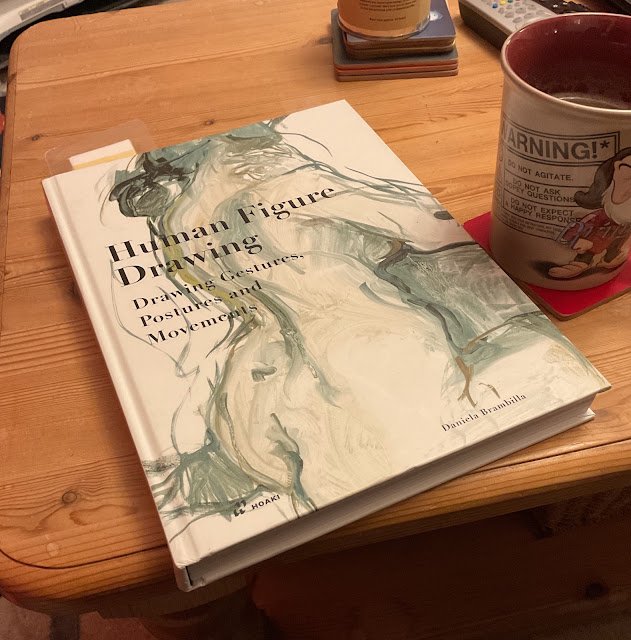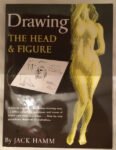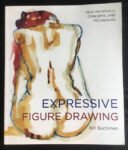And now for something completely different. A book that can't be read. This isn't a…

Human Figure Drawing, Daniela Brambilla – Book Review
On to the last of my Christmas books. I’ve been looking forward to this one as it’s an absolute monster. It’s nit just hardback, it’s not just 256 pages long. It’s also a little bit taller and wider than all my other books. And the paper inside it is matte rather than glossy. This book has gravitas and it feels important even before looking inside.
I’m going to start with a huge criticism. The back of the book says that it “aims to teach the secrets of drawing the human figure” and that it’s aimed at “those who want to draw as well as those who are already proficient”. I really hope that it was the publisher that wrote this and not the author because it’s blatantly untrue. This isn’t a book that teaches: it’s a book that provides some tips to and sets a few exercises for experienced artists. If you’re not an experienced artist, walk away now. You need to have read either Betty Edwards or Bert Dodson and followed it up with Chris Legaspi, Steve Huston or something similar.
The book has eighteen chapters on:
– gesture drawing
– contour drawing
– combining the two
– lines of force
– proportions
– filling out shapes from inside with scribbles
– negative drawing
– drawing from memory
– balance
– trying out other media
– light and shadow
– drawing with multiple values
– composition, viewing angle, etc
– what to say
– character
– age and what makes different people different
– sketchbooks
– using imagination to make things more interesting
It’s a pretty comprehensive list of chapters. Some of these chapters have similar names to those in the Bert Buchman book, and I’m going to compare and contrast the two books later in this review. I’ve written down on the list what the chapters are about rather than Daniela’s chapter names, I have to point out an issue I have with one of them. The chapter that’s on doing drawings with multiple values is titled “chiaroscuro” but my understanding of chiaroscuro is that it’s about contrasting light and dark areas against each other – something vaguely similar but not the same.
As for content in the individual chapters, most of it was ideas for exercises, with the odd useful tip thrown in. At the end of each chapter there’s a bullet point list of exercises. But my problem is the lack of teaching in the book. There’s no description, for example of what gesture drawing is (read Betty Edwards) or what lines of force are (I think this may be about imagining the backbone, hipline and shoulder line as making up a bendy capital I, which I read in another book at some point). Contour drawing is glossed over too: Charles Reid gives the best explanations of this in all his books. There are a lot of pictures in this book but with no attaching text to tell us whether, let alone where, they fit with the test of the story. And I’m not a fan of Daniela’s writing style. It’s a bit too waffly and I less for my liking and her paragraphs are so long that they go over multiple pages, meaning that many readers will skip some of the illustrations.
So, yes, it’s not a book that attempts to teach the reader anything. And the pictures are disconnected from the text. Some of the pictures are useful, illustrating things that Daniela doesn’t explain, but you have to work hard looking at them and trying to work out whether they’re actually linked to what’s going on in the main body of text.
I see this book as a book of exercises. I’ve seen that there’s an exercise book by Betty Edwards that people can buy to go with her Drawing On The Right Side Of the Brain book. I’ve never looked inside it but understand that it’s all just exercises and that all the teaching is in the main book. It would be a mistake for someone to go out looking for the main book and come back with the exercise book: on its own it would be useless. I think this book is like that exercise book of Betty’s.
This book also reminds me of the Bill Buchman book. Both are books with exercises to try after reading books on drawing and figure drawing. Of the two, I prefer Bill’s. It’s an easier read, easier to follow and includes text with all the illustrations whether they represent demos or completed paintings. But the exercises in the two books go down two very different roads: Daniela’s work is much more conventional and Bill’s more abstract. Another reason why I prefer Bill’s but that last reason is a personal preference, whereas my other reasons are all about Bill’s book being better. After reading Daniela’s book, I’m feeling a greater appreciation for Bill’s and am pushing its rating up from three palettes to four.
So this one’s badly written, has lies on the back cover and doesn’t really teach the reader anything (I’ve not even made any notes on it). But it’s not a complete disaster. An experienced artist wanting to fine tune some aspect of their figure drawing could dip into the relevant chapter(s) and find some exercises (and the odd tip) to improve his skills. For me at the moment, that might mean the chapters on gesture drawing and on combing gesture and contour drawing. Although I’d probably go for the Buchman book first.
I’m finding myself starting to go round in circles, so I’ll cut to the chase. This book does serve a purpose, for an artist at a particular level looking for ideas for exercises to improve his skills in different aspects of figure drawing. I personally prefer Buchman. Others won’t. This is looking like a two paletter. It won’t get many rereads from me unless I become more conventional or need more ideas to supplement Bill’s but I can see how it would be useful to others, so it’s not making me angry. It does come with a warning, though, that it’s only for experienced artists who already know what things like gesture and contour drawing mean.
⚠️ Warning! 🎨🎨 Danger! ⚠️
You can find this book and more reviews of it at Amazon UK here. As an Amazon Associate, I earn commission from qualifying purchases but this costs absolutely nothing extra to you.








Leave a Reply